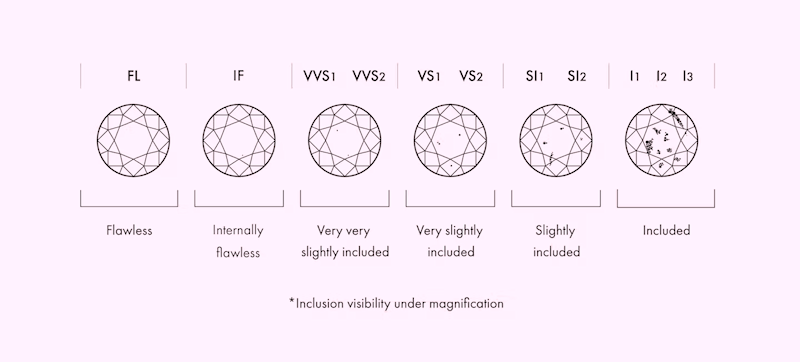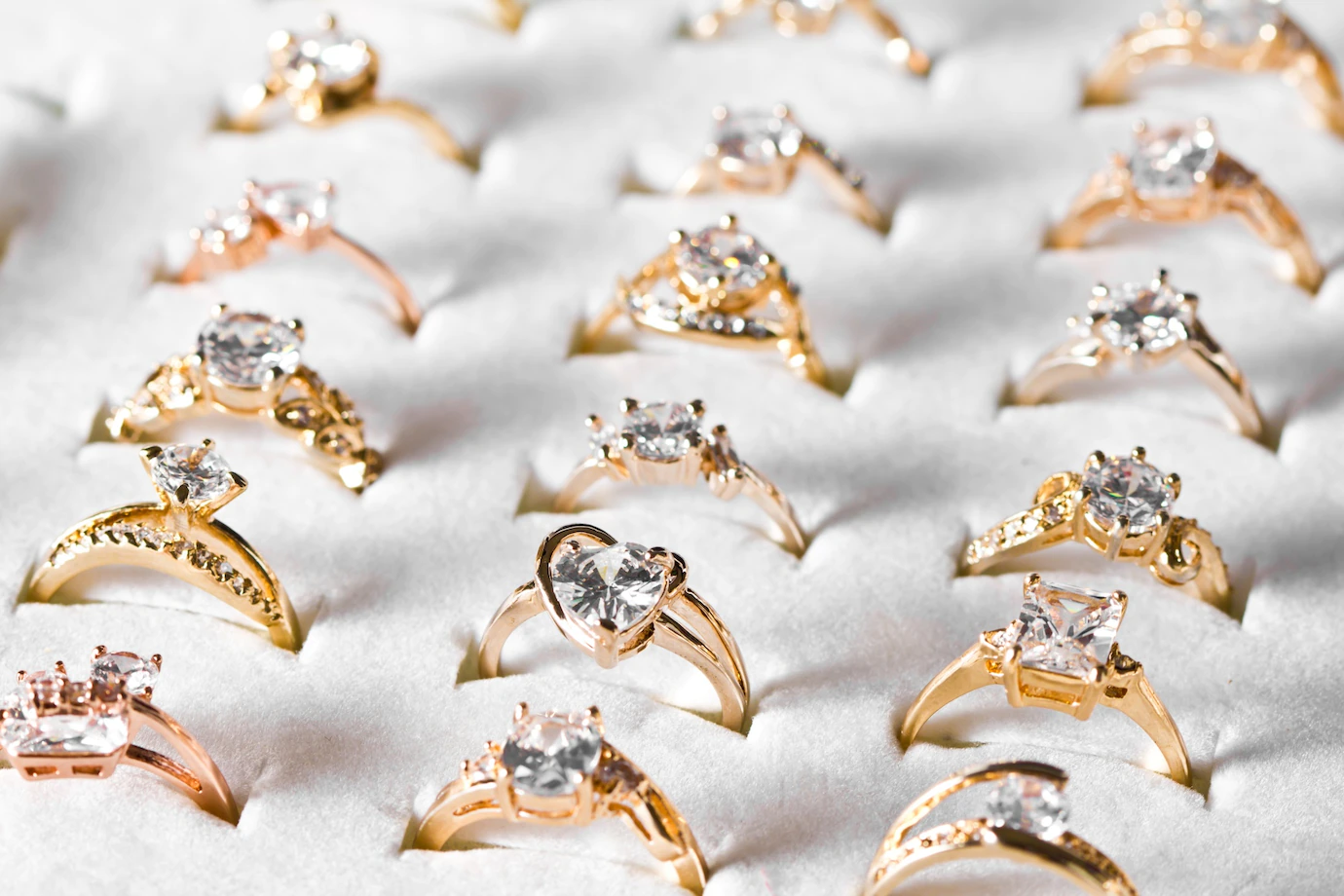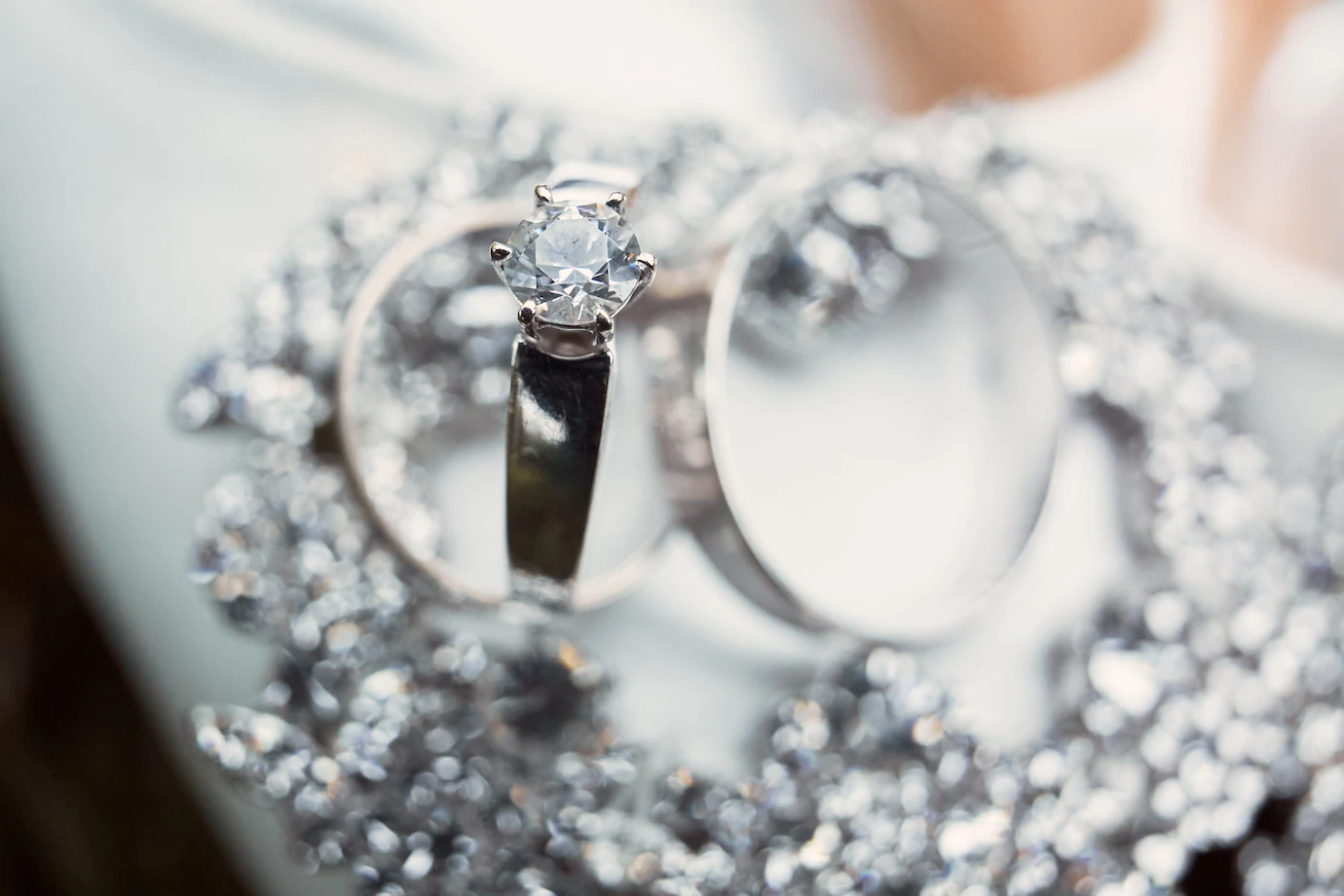
Diamond clarity grading is the process of evaluating the visual appearance of a diamond, specifically the presence and size of inclusions and blemishes. Inclusions are small imperfections that are present within the diamond, while blemishes are surface imperfections. The clarity grading system is used to determine the quality and value of a diamond, and is one of the Four Cs of diamond grading, along with cut, color, and carat weight.
Inclusions are internal imperfections that are typically formed during the diamond’s natural growth process, while blemishes are external imperfections that can be caused by external factors such as wear and tear or the cutting and polishing of the diamond.
The diamond clarity grading system was developed by the Gemological Institute of America (GIA) in the 1950s, and is widely considered to be the industry standard. The system consists of 11 clarity grades, which range from Flawless (FL) to Included (I3).
The different types of clarities:
Please note, the text below contains links for every kind of inclusion grade. If you would like to know more the clarity type, click the links for detailed information.
There are four main types. Click on the name of the grade if you wish to learn more information about the cut grade.
- Flawless (FL) diamonds are the highest clarity grade, and have no inclusions or blemishes that are visible under 10x magnification. Internally Flawless (IF) diamonds have no inclusions that are visible under 10x magnification, but may have some surface blemishes.
- Very, Very Slightly Included (VVS1 and VVS2) diamonds have inclusions that are difficult to see under 10x magnification, and are considered to be high quality.
- Very Slightly Included: In terms of appearance, VS1 and VS2 diamonds may have some visible inclusions when viewed under magnification, but they will still have a high level of sparkle and brilliance.
- Slightly Included (SI1 and SI2) diamonds have inclusions that are easily visible under 10x magnification, but are still considered to be of good quality.
- Included (I1, I2, and I3) diamonds have inclusions that are easily visible to the naked eye, and are considered to be lower quality.
The clarity grade of a diamond is determined by a trained gemologist, who uses a microscope to carefully examine the diamond for inclusions and blemishes. The grading process is highly standardized, and the same criteria are used for all diamonds, regardless of their size or shape.
In general, the higher the clarity grade of a diamond, the more valuable it is. Flawless and Internally Flawless diamonds are the most rare and valuable, and are typically reserved for high-end jewelry. However, many consumers opt for diamonds with lower clarity grades, as they offer a good balance of quality and affordability.
Diamond clarity grading is an important aspect of the jewelry industry, and helps consumers to make informed decisions when purchasing diamonds. It is a critical component of the Four Cs of diamond grading, and is a key factor in determining the value and quality of a diamond.
10x magnification is a standard measurement used in diamond grading to evaluate the clarity of a diamond. When a diamond is viewed under 10x magnification, a trained gemologist can see inclusions and blemishes that may not be visible to the naked eye.

4 Things To Keep In Mind About Clarity
- The visibility of the inclusions. The clarity of a diamond is determined by the visibility of its inclusions under 10x magnification. However, it is important to remember that these inclusions may not be visible to the naked eye, and may not have a significant impact on the overall appearance of the diamond.
- The setting of the diamond. The setting of a diamond can also affect its appearance and overall value. In some cases, a well-made setting can enhance the beauty of a diamond and make its inclusions less noticeable. In other cases, a poorly made setting can detract from the diamond’s overall appearance.
- The cut of the diamond. The cut of a diamond refers to its proportions and symmetry, which can affect the diamond’s sparkle and brilliance. A well-cut, symmetrical diamond can maximize its optical properties and create a stunning visual effect, regardless of its clarity.
- The color of the diamond. The color of a diamond can also affect its appearance and value. Diamonds are typically colorless, but they can also come in shades of yellow or brown. In some cases, a slightly colored diamond can have a warm, attractive appearance, and may be more affordable than a colorless diamond.
How Rare Are Is Which Level Of Clarity, Statistically Speaking?
The rarity of a diamond is determined by a number of factors, including its clarity, color, and carat weight. In general, diamonds with higher clarity grades are considered to be rarer and more valuable than those with lower clarity grades.
According to the Gemological Institute of America (GIA) Diamond Clarity Scale, diamonds with a clarity grade of FL or IF (flawless or internally flawless) are the rarest, with less than 1% of all diamonds falling into this category. Diamonds with a clarity grade of VVS1 or VVS2 (very slightly included) are also considered to be rare, with less than 4% of all diamonds falling into this category.
Diamonds with a clarity grade of VS1 or VS2 (very slightly included) are slightly less rare, with approximately 8-10% of all diamonds falling into this category. Diamonds with a clarity grade of SI1 or SI2 (slightly included) are even less rare, with approximately 15-20% of all diamonds falling into this category.

In Some Cases, It Is Possible To Hide The Inclusions
Strategically placing diamonds with inclusions in the right setting can be a effective way to distract from the presence of larger inclusions and enhance the overall appearance of the diamond. In some cases, a well-made setting can enhance the beauty of a diamond and make its inclusions less noticeable.
One way to do this is by choosing a setting that has a lot of visual interest and detail, such as a halo setting or a pave setting. These types of settings can draw the eye away from the inclusions in the diamond and create a stunning visual effect.
Another way to strategically place a diamond with inclusions is by choosing a setting that has a contrasting color, such as a white gold setting for a yellow diamond or a yellow gold setting for a white diamond. This can create a striking visual contrast and make the inclusions in the diamond less noticeable.
Additionally, choosing a setting that surrounds the diamond with smaller, sparkly diamonds can also help to distract from the presence of inclusions. These smaller diamonds can create a halo of sparkle and brilliance around the center diamond, making it more visually appealing and drawing attention away from any inclusions.
Overall, strategically placing a diamond with inclusions in the right setting can be an effective way to enhance its overall appearance and make its inclusions less noticeable. By choosing a setting that has visual interest, contrast, and sparkle, you can create a beautiful and eye-catching piece of jewelry that showcases the diamond in its best light.